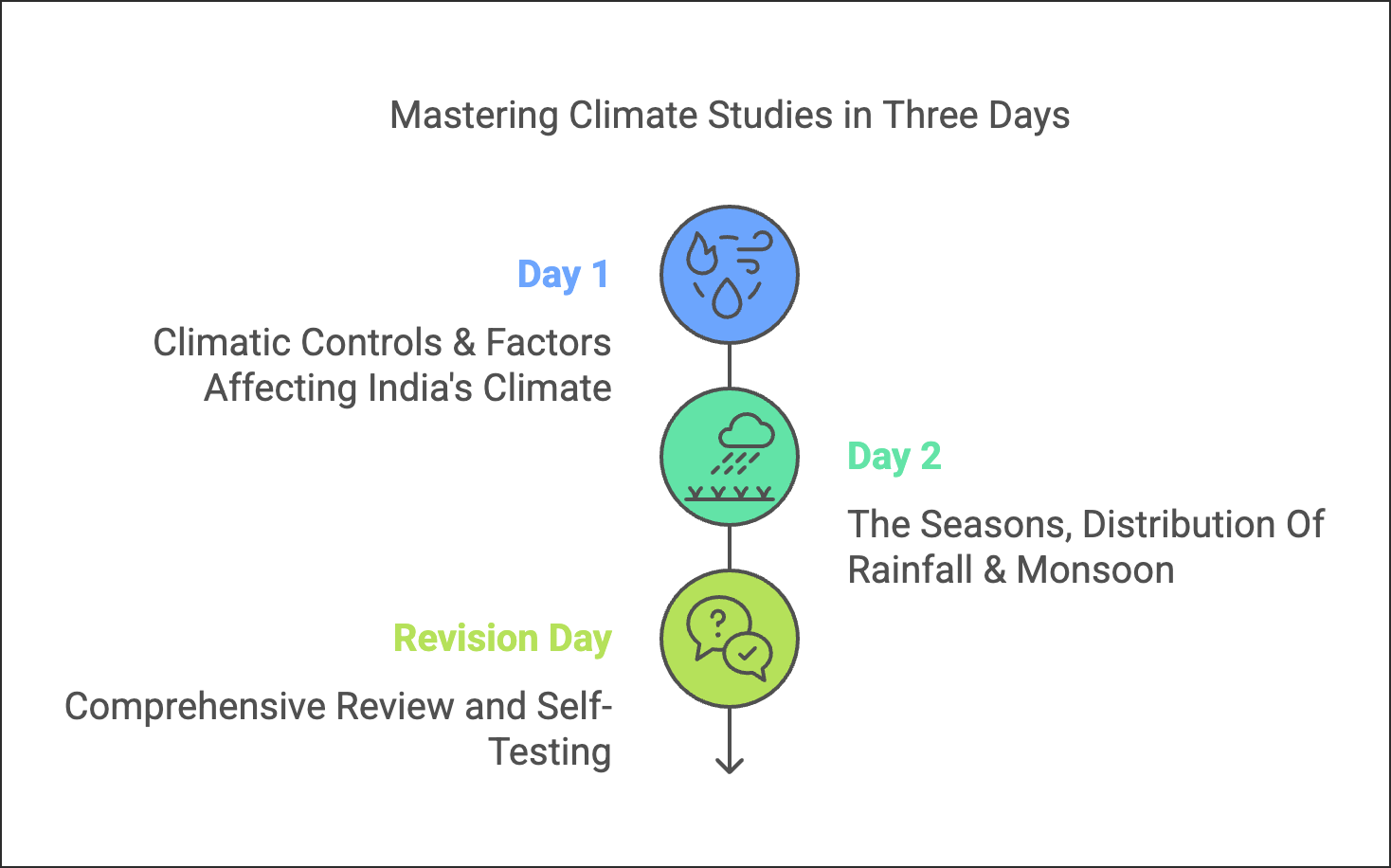2 Days Timetable: Climate | Social Studies (SST) Class 9 PDF Download
| Table of contents |

|
| Topics to Cover |

|
| Day 1: Climatic Controls & Factors Affecting India’s Climate |

|
| Day 2: The Seasons, Distribution Of Rainfall & Monsoon As A Unifying Bond |

|
| Revision |

|
The Climate chapter in Class 9 Social Science (from Contemporary India - I) isn’t just another topic—it’s your key to understanding why India experiences diverse weather patterns, from scorching summers to heavy monsoons! This chapter will help you decode climatic controls, monsoons, rainfall distribution, and seasonal changes—all essential for both exams and real-world understanding.
By following this study plan, you'll not only grasp the concepts effortlessly but also develop a winning strategy to tackle exam questions with confidence. So, let’s dive in and make learning about climate exciting and easy!
Topics to Cover
- Climatic Controls
- Factors Affecting India’s Climate
- The Seasons
- Distribution Of Rainfall
- Monsoon As A Unifying Bond

To assist you in your preparation, EduRev provides resources such as notes, videos, and tests for each topic. You can find the links for the required topics inside each day of the study plan.
Study Plan for "Climate"
We'll adopt a 2-day strategy to cover the topics and dedicate one extra day for revision. Please refrain from adding any additional days after the revision.
Day 1: Climatic Controls & Factors Affecting India’s Climate
What to Cover:
- Climatic Controls
- Factors Affecting India’s Climate
Study Tips:
- Start by referring to the NCERT Textbook for Climate to understand the fundamental concepts.
- Complement your reading with NCERT Solutions for Climate to ensure you grasp the concepts thoroughly.
- Utilize the Detailed Chapter Notes on EduRev for additional insights and clarifications.
Day 2: The Seasons, Distribution Of Rainfall & Monsoon As A Unifying Bond
What to Cover:
- The Seasons
- Distribution Of Rainfall
- Monsoon As A Unifying Bond
Study Tips:
- Start with a quick revision of the previous day's topics to strengthen your understanding.
- Explore the Mindmap: Climate on EduRev to visualize and connect key concepts.
- Solve practice questions and assess your knowledge using Practice Questions: Climate.
Revision
On your revision day, ensure that you:
Review all the topics covered in the past two days.
Test yourself with various question types, including:
- Past Year Questions
- Topic Wise Tests
- HOTS Questions
- Assertion & Reason Type Questions
- Case Based Questions
- Long Questions & Answers
- Short Questions & Answers
- Very Short Questions & Answers
Remember, consistent practice and revision are key to mastering the chapter on Climate in Class 9 Social Science.
Here are all the relevant links categorized under suitable headers:
Useful Links:
- Class 9 Exam
- Social Studies (SST) Class 9
- Previous Year Questions: Climate
- Chapter: Climate
- Detailed Chapter Notes
- NCERT Textbook for Climate
- NCERT Solutions for Climate
- Worksheet for Climate
- Worksheet Solutions for Climate
- Short & Long Questions & Answers: Climate
- Key Concepts: Climate
- Mindmap: Climate
- Practice Questions: Climate
- HOTS Questions: Climate
- Assertion & Reason Type Questions: Climate
- Case Based Questions: Climate
- Long Questions & Answers: Climate
- Short Questions & Answers: Climate
- Very Short Questions & Answers: Climate
You can use these links for quick access to relevant resources and study materials as mentioned in the study plan.
Good luck with your studies!
|
55 videos|637 docs|79 tests
|
FAQs on 2 Days Timetable: Climate - Social Studies (SST) Class 9
| 1. What are the main climatic controls that affect India’s climate? |  |
| 2. How do the seasons change in India? |  |
| 3. What is the significance of monsoon in India? |  |
| 4. How does the distribution of rainfall vary across India? |  |
| 5. What factors contribute to the variability of the monsoon? |  |





















